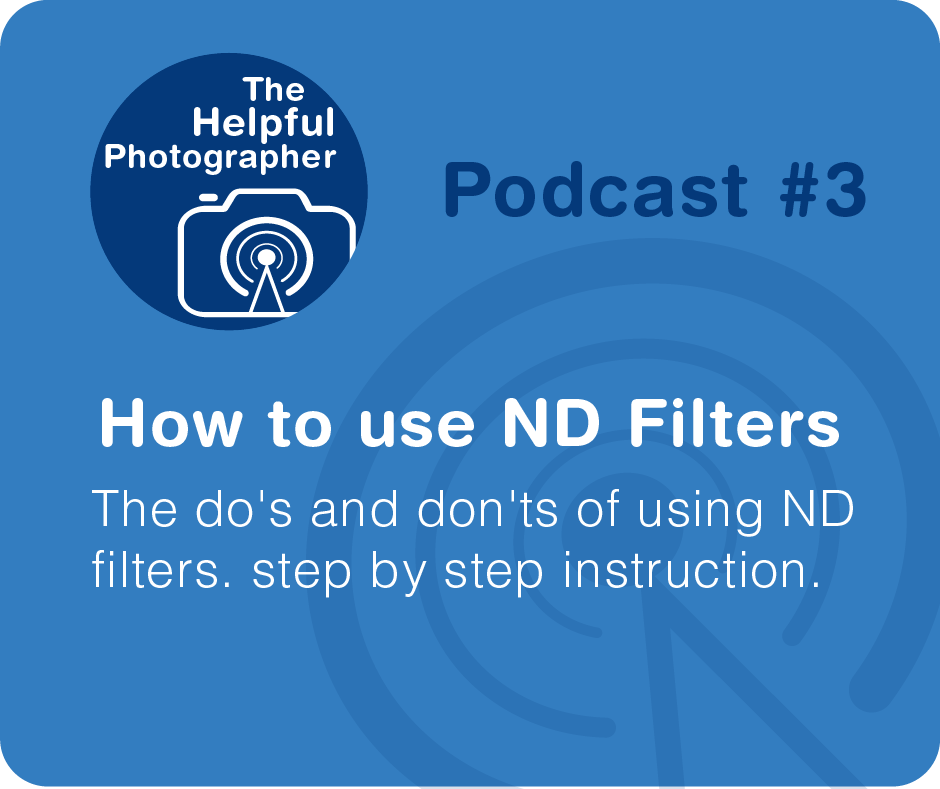How to use ND Filters - Photo Tips
Photo Tips Podcast - How to use ND Filters/Photo Tips #3

One might think that using an ND filter is as easy as mounting it to the front of your camera but in the end it’s not that obvious and there’s a little more to it than one might think. Before you mount your filter, you should remove any other filter you already have on your lens and make sure your lens is clean while you are at it. As you mount it make sure it’s properly threaded; if it’s wonky the filter may drop off your lens when you decide to move your camera or lens around. And at an average price of $150 per filter this would hurt your wallet a lot.
One of the main problems I have found with using a 10 or 15 stop ND filter is if you are working in moderately low light you may have a hard time seeing through your view finder or your camera may have a hard time focusing because it’s too dark. One work around is to use live view, but even then it may not be enough. So you have 2 choices. You can remove the filter and make sure you nail your focus and composition before you mount your filter; this will work both in live view or while using your view finder. Another option is to move your ISO up as high as it will go temporarily. This will only work in live view because moving your ISO won’t change what you see through your viewfinder.
The next thing you’ll need to do is establish your exposure but that’s a much longer discussion and I’ll post a podcast on that later this week. So once you have established your composition and exposure, you’re going to want to cover your view finder. You can do this with a black piece of tape or a towel or whatever you have handy. The reason for this is because very often you’ll get a light leak from your view finder. This sounds a little bit odd but it’s more common than you think. So let me explain the problem. When you press the shutter button on a DSLR camera, the mirror inside your camera flips up to allow light to hit the sensor. In theory the mirror is supposed to create a complete seal and any light entering from the viewfinder would not affect the image. In reality this isn’t always the case. I did speak to Canon and Nikon regarding this issue and it would seem that Canon reps believe that it’s supposed to create a complete seal and my experience with a new Canon camera confirms this but as you put more shutter actions on the camera the seal is lost causing light leaks. Nikon reps don’t believe you’ll get a complete seal at all.
This is a real problem when we’re shooting long exposures in the middle of the day because we’re always on a tripod and rather than having our eye next to the viewfinder, blocking any light that comes in, we’re standing next to our camera and sometimes with the sun behind the camera! And next thing you know, you have a weird streak of light on your image. If you don’t believe you have a complete seal, just run a test! Take your camera outside in the middle of the day on a tripod in the middle of the day. Close your aperture down to f/22, put a lens cap on the lens and then put a towel over the lens and open the shutter for 20 or 30 minutes. Make sure to leave the viewfinder exposed to the sun. If the image is completely black you know that you have a good seal, otherwise, you’ll have to cover the viewfinder when shooting with long exposure in bright light.
Although I know I have a good seal on my camera, because I tested, I don’t know when that seal will go bad so I always cover my viewfinder when I’m shooting long exposure in bright light. Here’s nifty little trick, take a 1 inch role of black masking tape or black duct tape and roll about 1-2 feet of it onto your tripod leg! This way you’ll always have tape on you. And in photography? We always need tape!
The last thing you need to know about shooting with an ND filter is that your metering system lives in the prism; it’s space between the mirror and the viewfinder. As a result your meter reading is affected by both the light that comes in from your lens and your viewfinder. So when you are doing a long exposure in the middle of the day you will want to cover your viewfinder with something, like your thumb or a piece of tape. This will help to insure a good reading. Again, I'll cover calculating exposures in the next podcast.
Hopefully that was helpful. Until next time, Keep on shooting!










